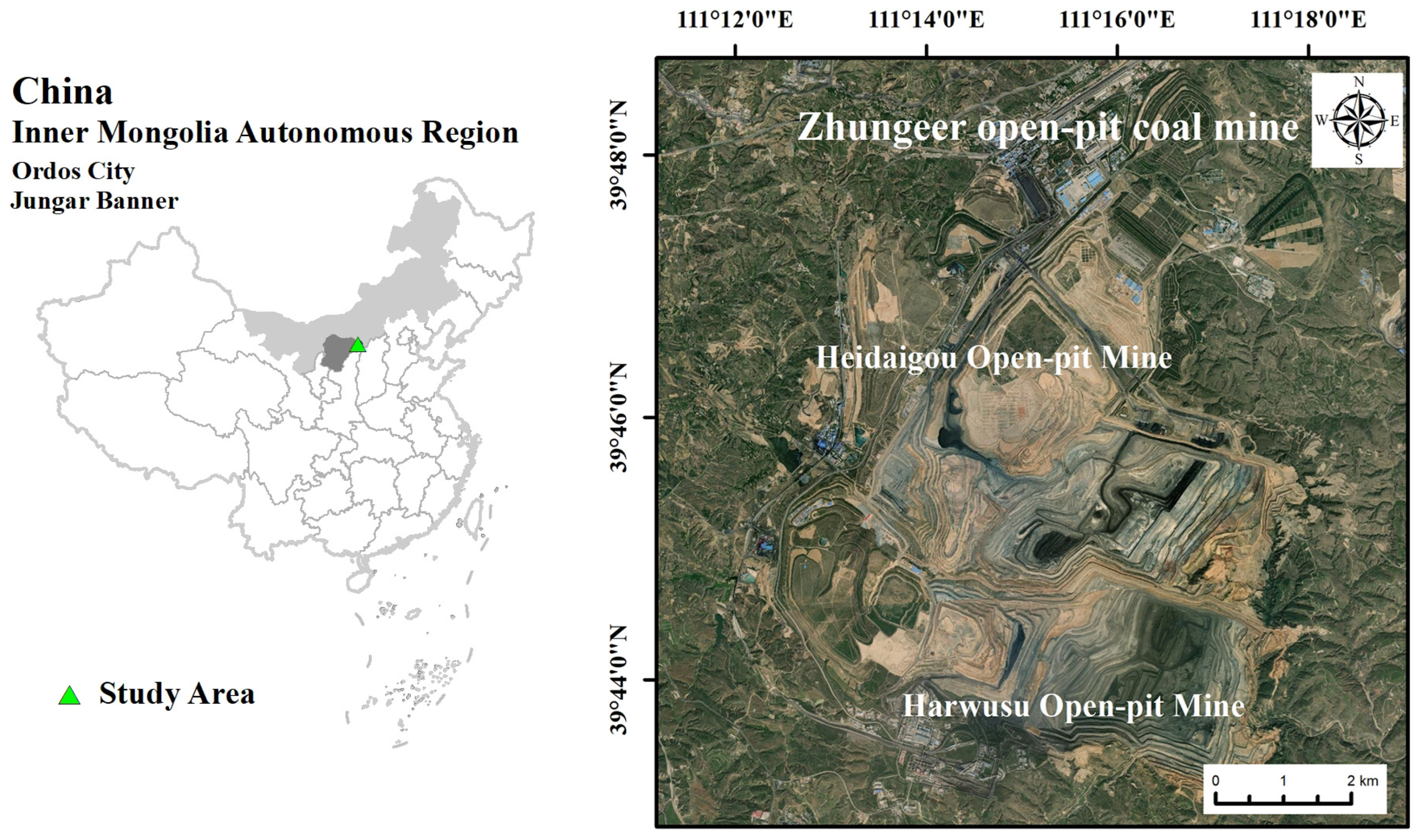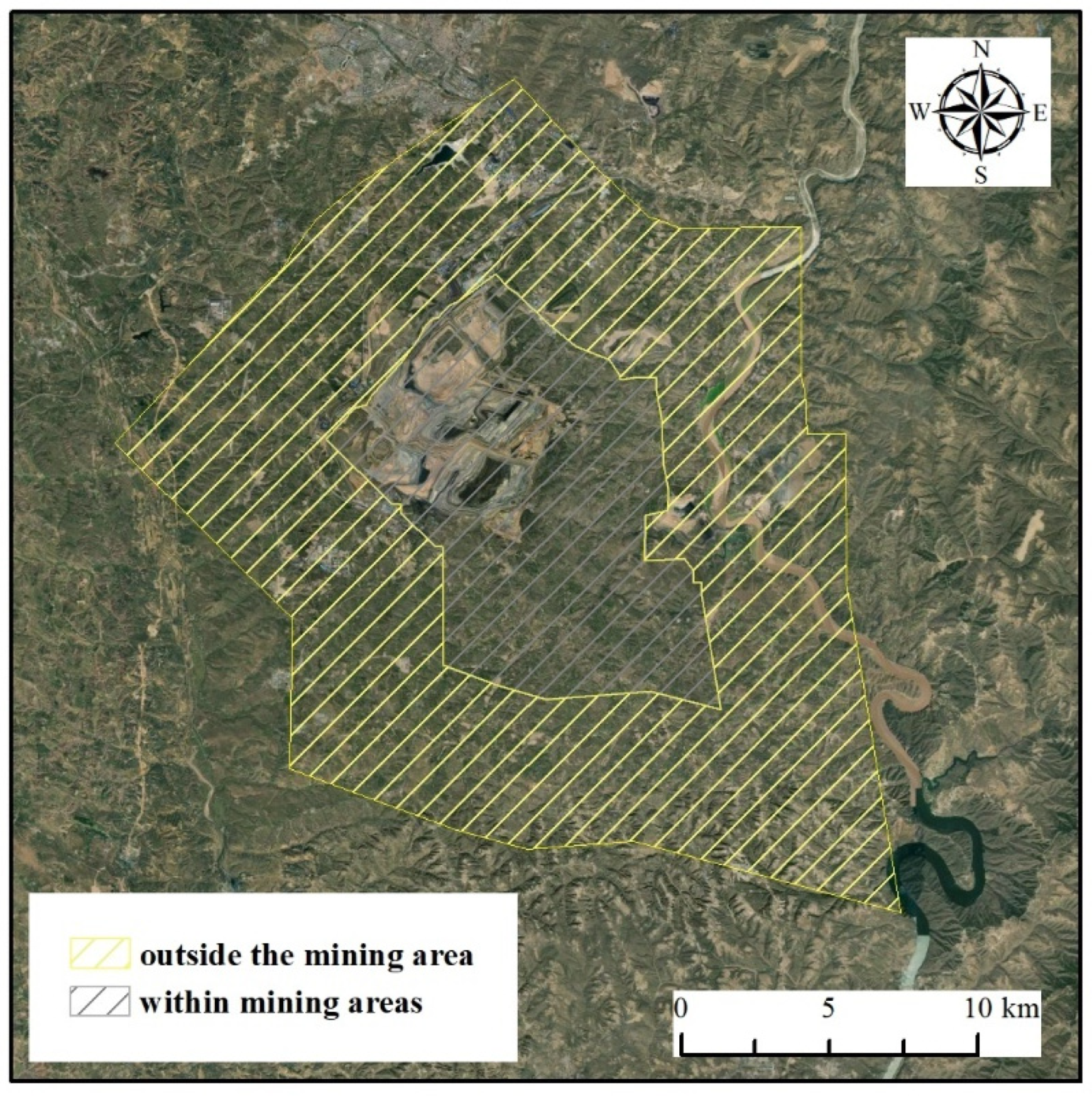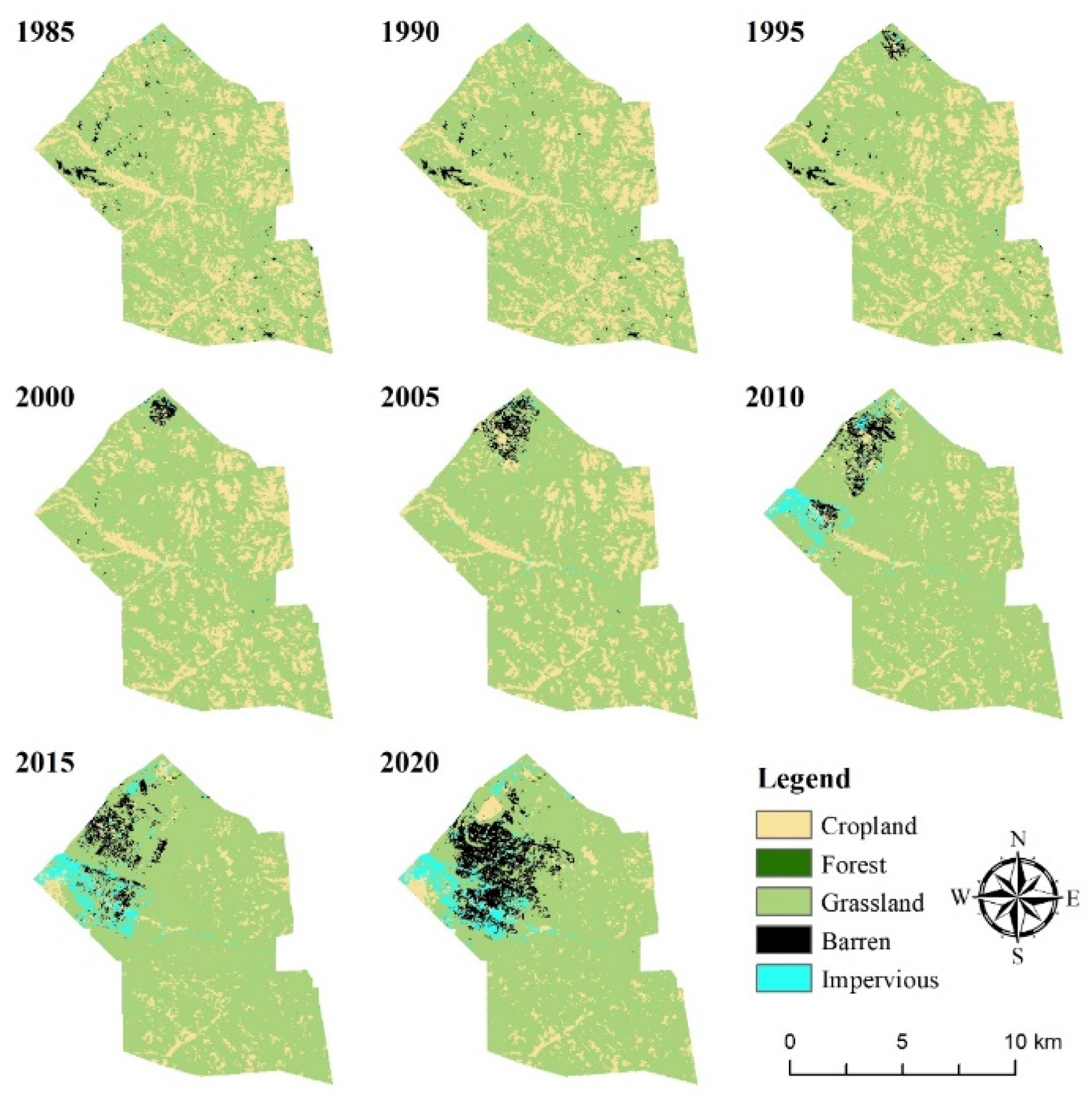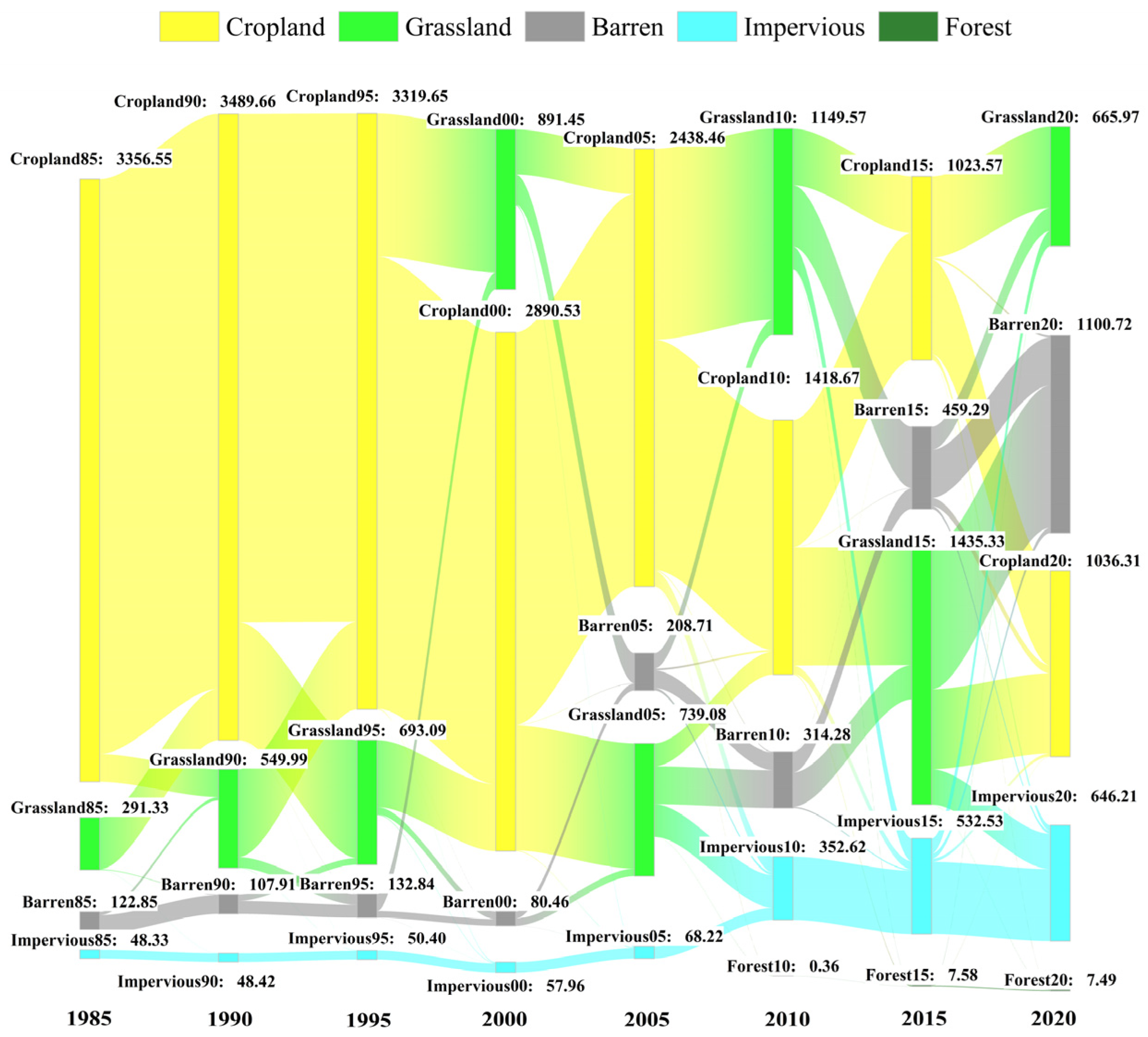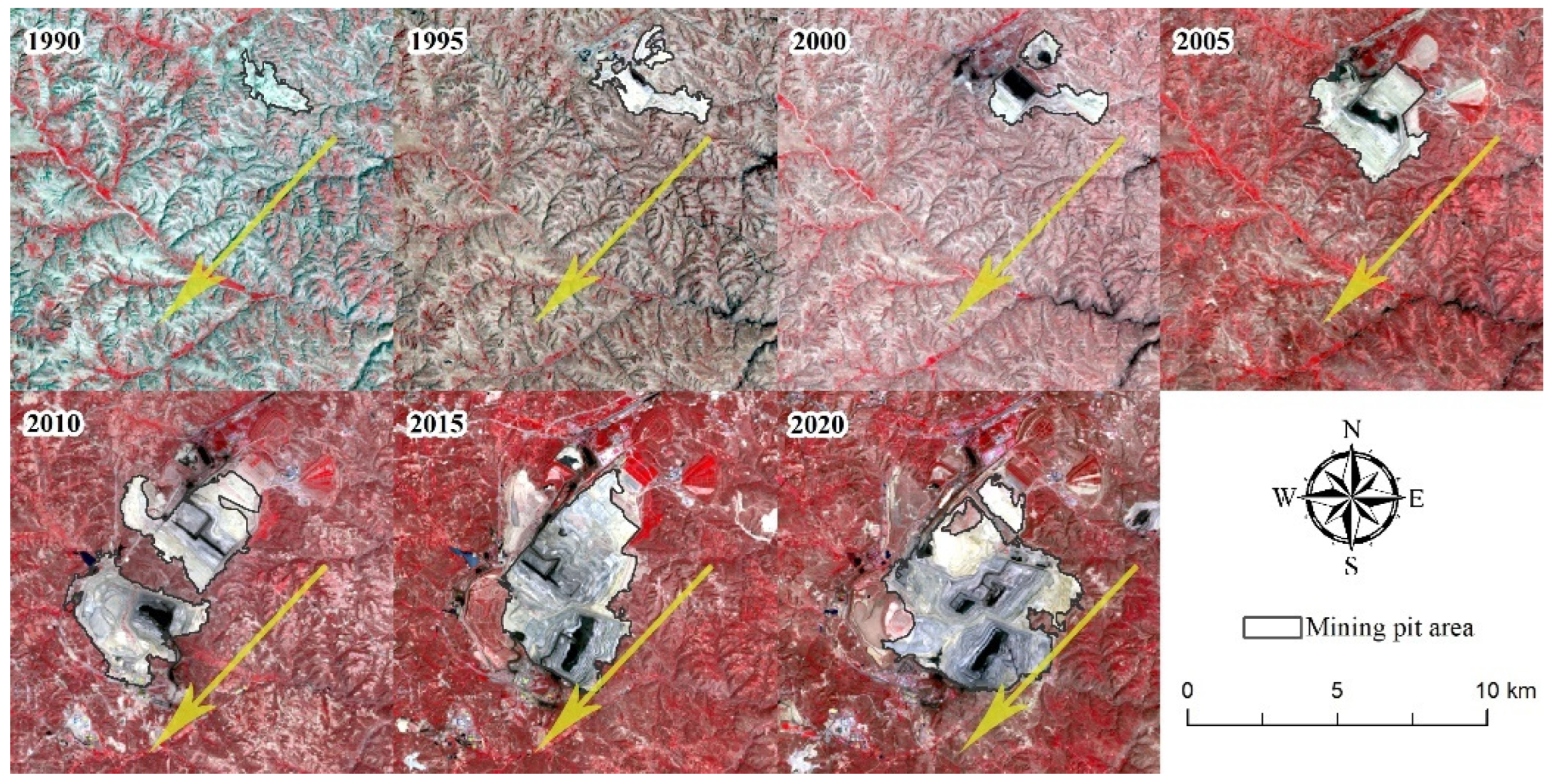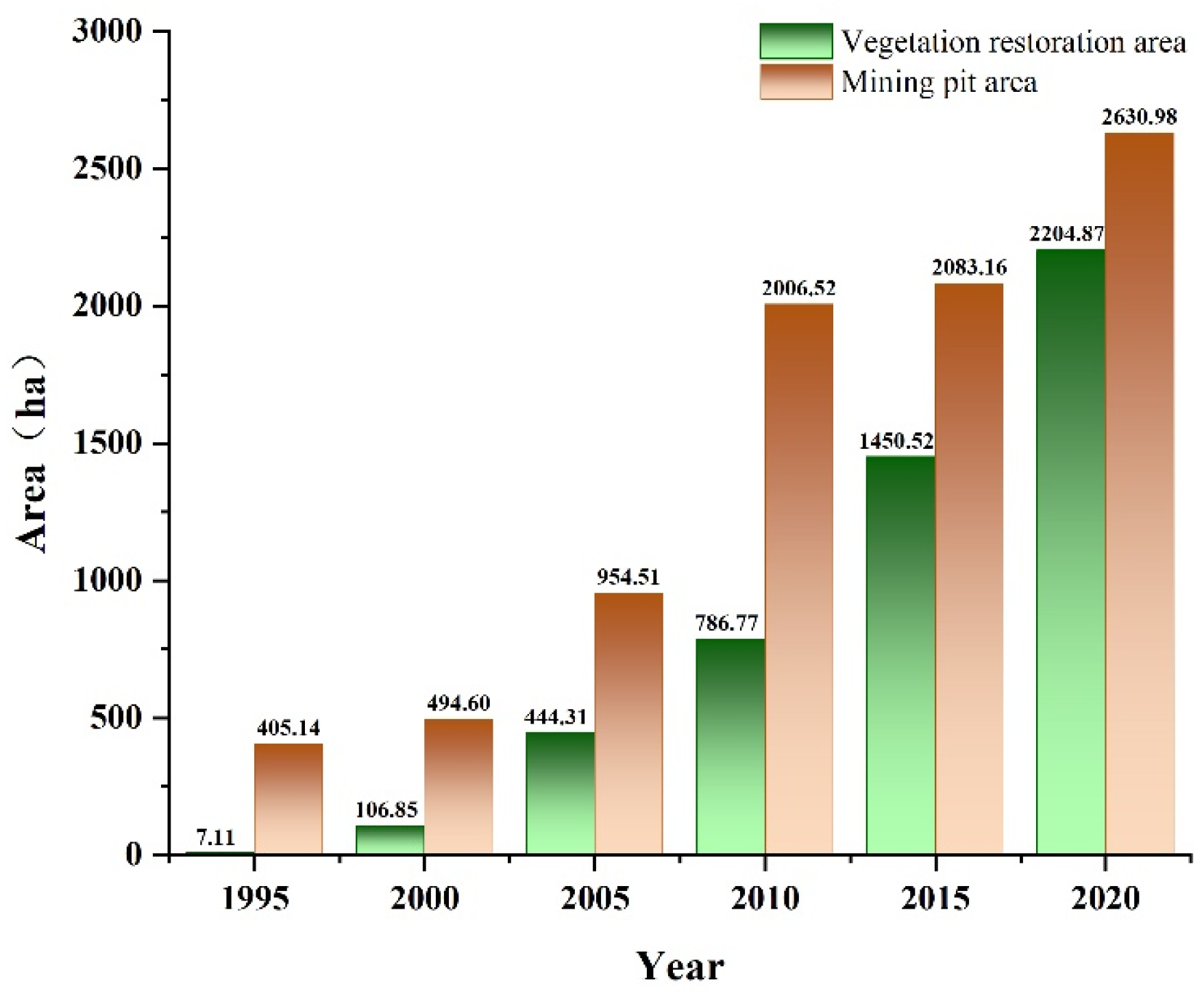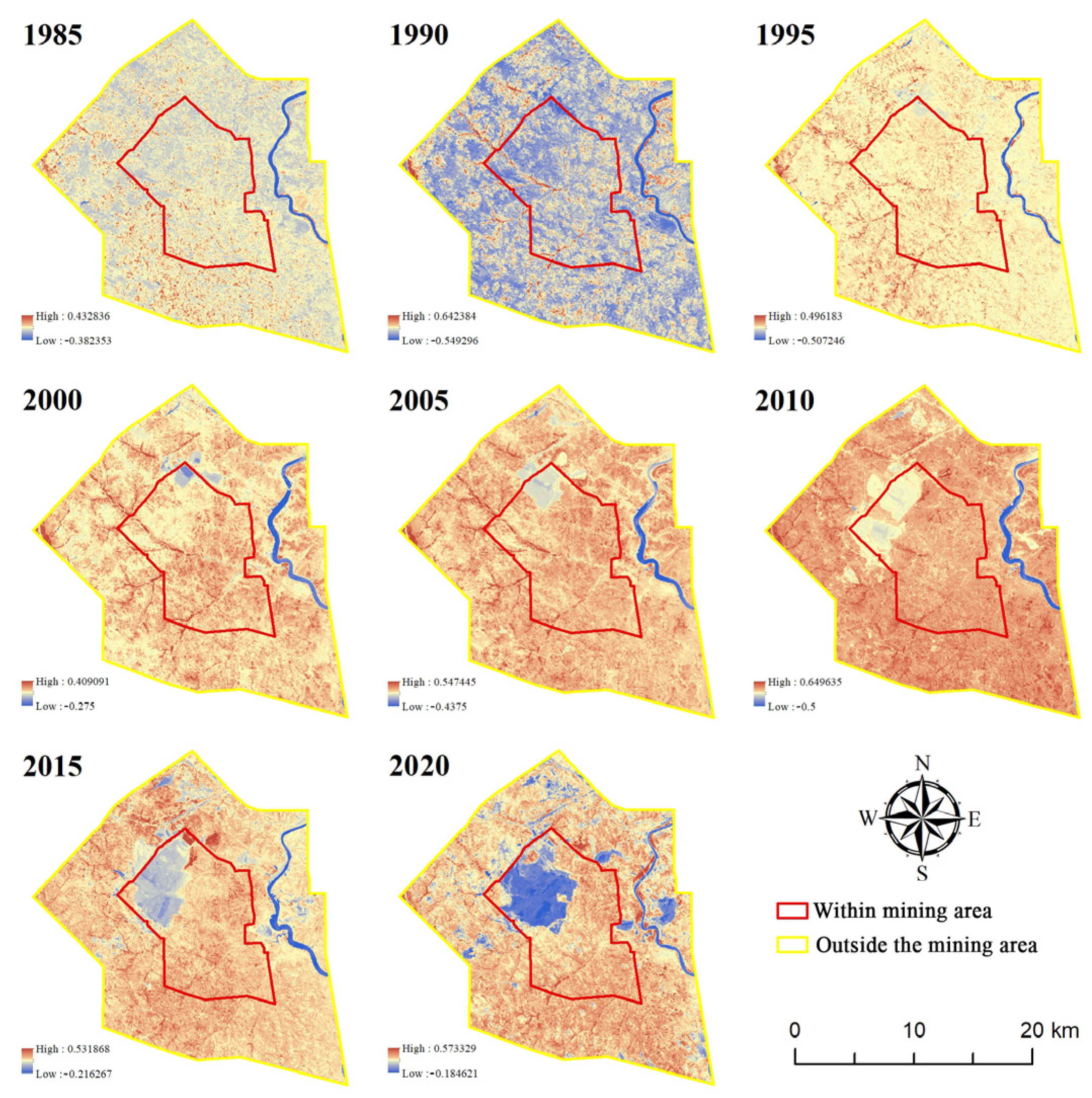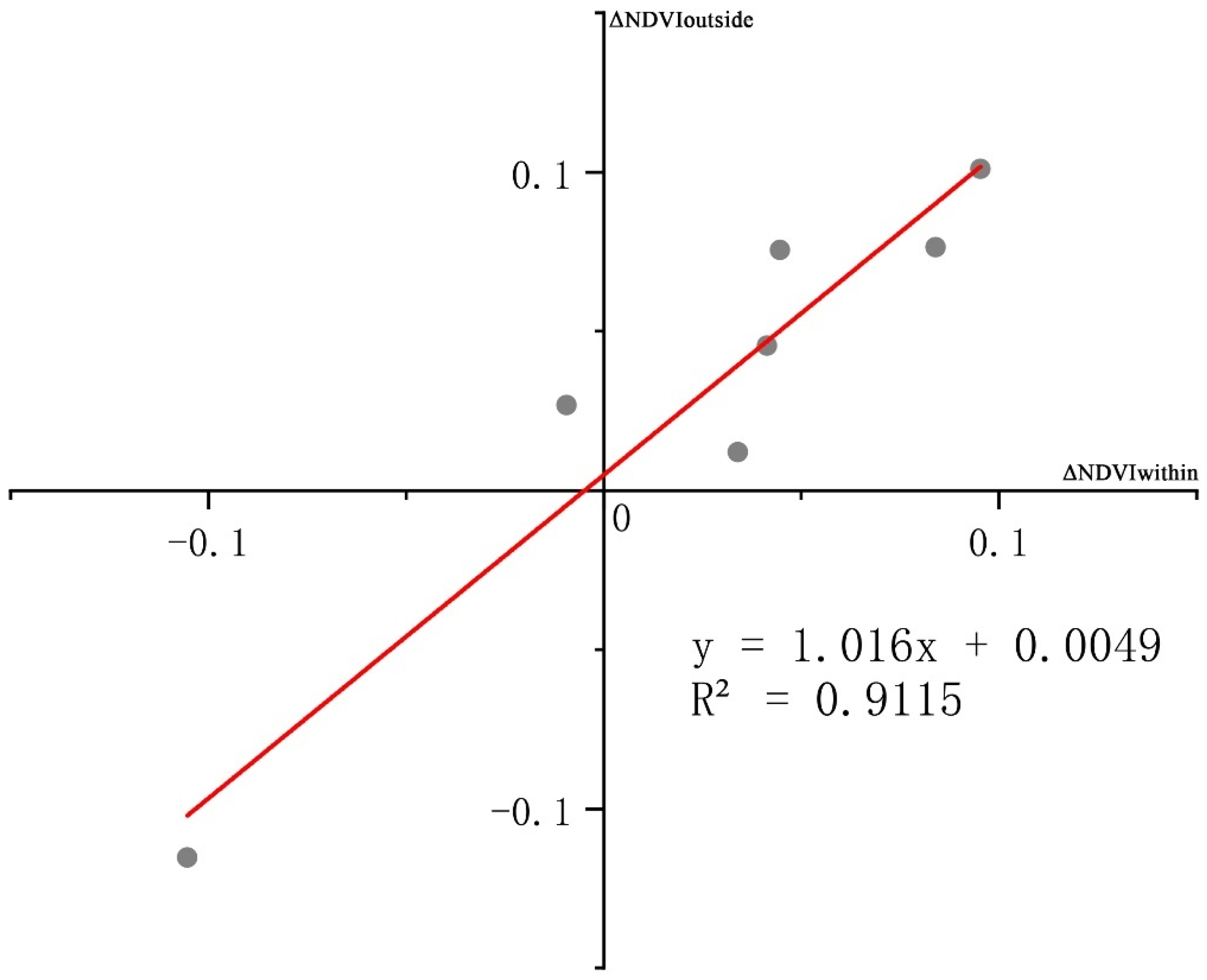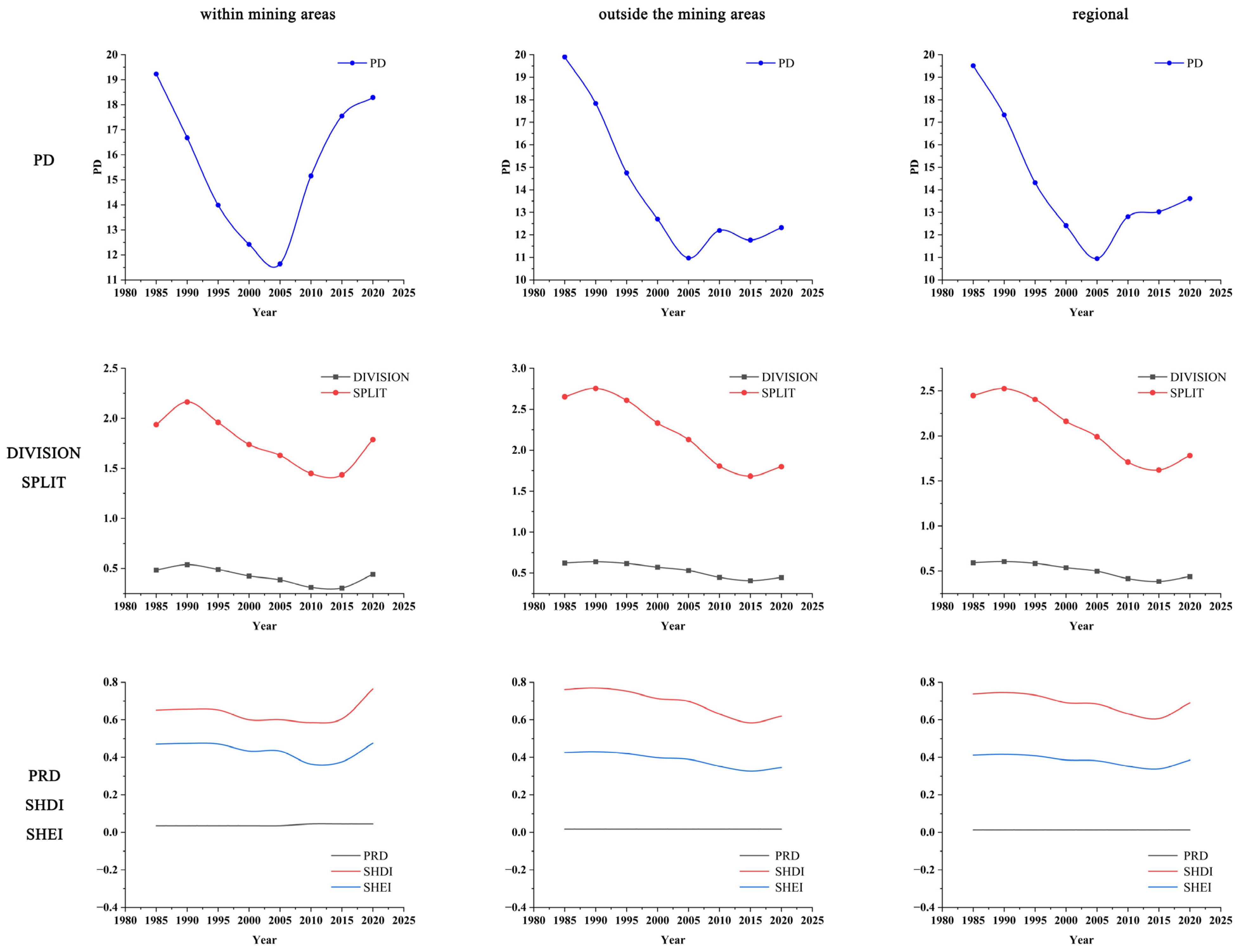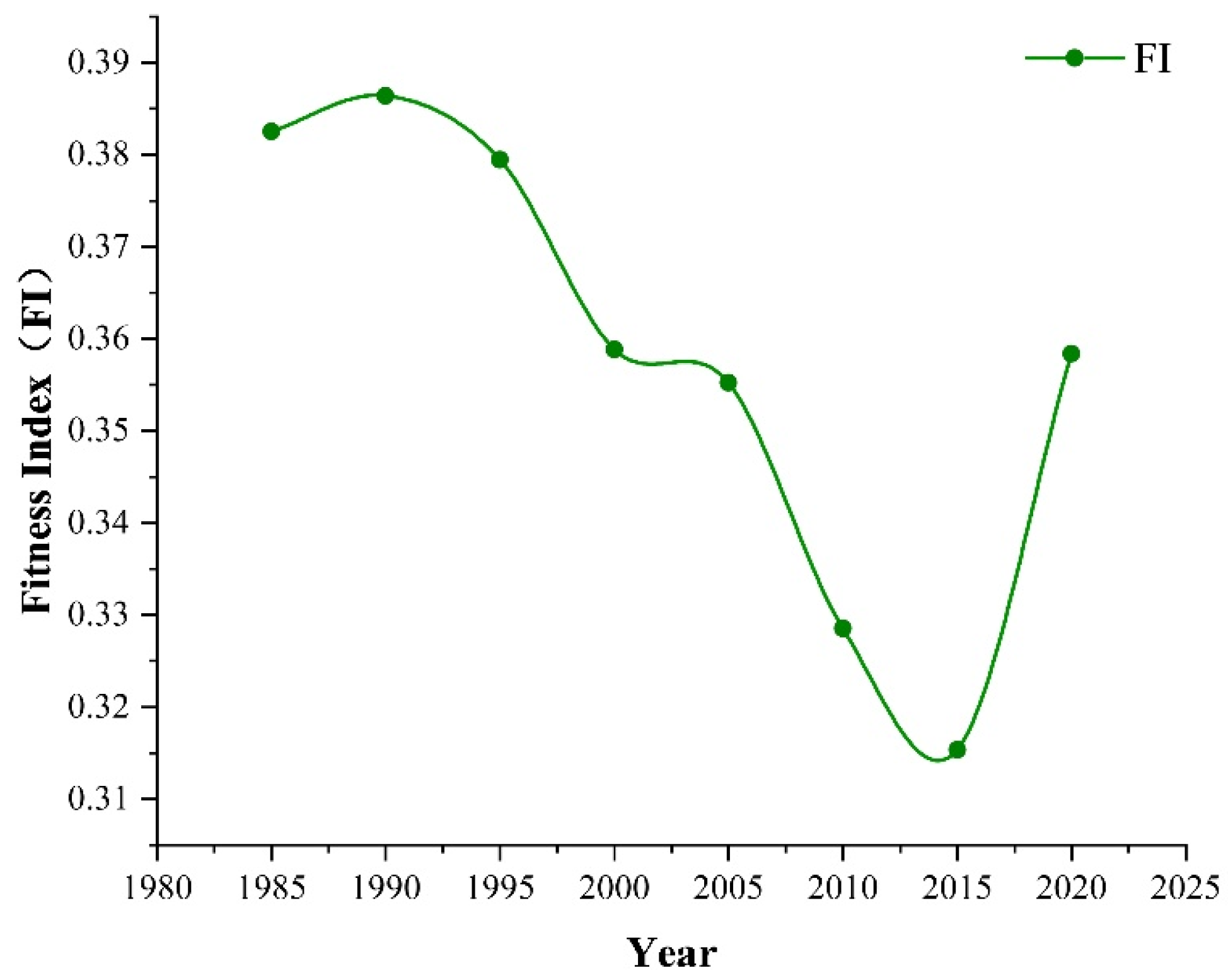1. Introduction
As the world’s largest producer and consumer of coal, China places significant reliance on open-pit coal mining for its energy supply [
1]. This intense anthropogenic activity inflicts direct damage upon the surface, resulting in soil erosion and the loss of biodiversity, thereby disrupting original land use patterns and the initial ecosystems [
2,
3]. Particularly in the arid and semi-arid regions of Northwest China, fragile ecosystems become increasingly sensitive to external disturbances following the impacts of open-pit mining activities [
4,
5]. Consequently, ecological restoration in mining areas has become critically urgent, promoting the development of green mining practices to mitigate the negative effects of open-pit coal mining on the ecological environment. Open-pit coal mining has precipitated a series of environmental issues, such as vegetation degradation [
6], soil erosion [
7], and heavy metal contamination [
8], all of which constitute significant threats to biodiversity, alter landscape patterns, and disrupt ecological functions, ultimately compromising the stability of the ecosystem in mining areas [
9]. Therefore, it is vital to clarify the impacts of open-pit mining activities on land use changes and the ecological environment in the affected regions, as well as to analyze the cumulative effects of ecological engineering both within the mining areas and beyond. The rapid and comprehensive advancement of 3S technology has provided remote sensing with a unique advantage in the dynamic monitoring of ecological conditions in mining areas, offering a practical solution for detecting ecological disturbances in coal mining regions [
10]. Xu et al. [
11] utilized multitemporal Landsat remote sensing imagery in conjunction with a random forest model to classify land use/land cover (LULC) in open-pit mining areas and their surroundings, exploring the evolution of landscape patterns related to these mining activities.
Some researchers have quantitatively assessed the impact of mining activities on ecological environments through indicators such as vegetation cover [
12], remote sensing ecological indices [
13], and landscape ecological health indices [
14]. However, these metrics merely reflect the ecological characteristics of the region at specific times and do not account for the reciprocal positive and negative effects between ecological engineering and open-pit mining activities. Recent studies have indicated that land use transition matrices [
15], which can represent phased changes within coal mining areas, may serve as quantifiable indicators of the impact of mining activities on the regional ecological environment. It is noteworthy that mining activities not only cause direct damage to the surfaces within the mining boundaries but also lead to ecological degradation beyond the mine, thereby affecting the overall ecological quality of the region [
16].
Currently, many experts and scholars have proposed using the theories of landscape ecology to provide decision-making support for comprehensive risk prevention in coal mining areas, which can effectively guide the optimization and management of landscape patterns in these regions. Zhang et al. [
17] used the transfer matrix and landscape pattern indices based on the GEE platform to analyze the spatiotemporal evolution trends of land use and landscape patterns over 20 years in 13 typical open-pit coal mines in Inner Mongolia and assessed the impact of ecological restoration projects on land use structure and landscape patterns. Chen et al. [
18] focused on the Shengli Open-Pit Mine in Xilin Gol, China, revealing the spatiotemporal impacts of large-scale open-pit coal mines on the landscape ecological health of semi-arid grasslands, and established a research system of landscape indices–pattern–evolution–driving forces–spatial statistics. Additionally, some scholars, in their research on the regional ecological impacts of mining activities, have considered indicators such as ecological integrity and biodiversity to accurately locate key landscape areas and establish key protection zones in coal mining areas. Wang et al. [
19] developed a model for identifying key landscape areas based on Landsat TM/OLI data and identified very important patches, important patches, and common patches around open-pit coal mines in the semi-arid grasslands of the Yimin open-pit mining area in China, enriching the foundation for ecological mapping and the construction of ecological security patterns. Research on the landscape structure, landscape stability, and landscape processes in coal mining areas has also gradually increased in recent years. Soumen et al. [
20] used satellite remote sensing data to study the land use changes and landscape fragmentation caused by open-pit mining activities in the Barabini C.D. block of West Bengal, India, and found that the changes in landscape structure caused significant spatial loss, directly leading to a decrease in regional sustainability. Feng et al. [
21] constructed three indices—NDVI central tendency, heterogeneity, and relative variability—based on normalized vegetation index (NDVI) time-series data grids, completing the identification of landscape dynamic processes and stability in semi-arid grassland coal mining areas in China. Furthermore, some studies have conducted buffer zone analyses outside the mining areas to clarify the ecological impact effects of mining activities on external regions. Wu et al. [
22] analyzed the theoretical reference range of the impacts of the Shengli Open-Pit Mine through buffer zone analysis, landscape ecological function contribution rates, and the modified landscape disturbance index, concluding that the grassland landscape around the mining area is primarily affected lightly. However, there is limited research that analyzes the land use type changes and landscape pattern evolution of open-pit mining areas from multiple perspectives in ecological environmental studies.
The Heidaigou and Harwusu open-pit mines, located in the southeastern part of Ordos City, Inner Mongolia, China, represent the largest open-pit coal mining area in Asia and lie within a typical arid and semi-arid region of China [
23]. Over the past 30 years, mining activities have resulted in severe soil erosion and vegetation degradation, impairing the ecological functions of the landscape and increasing ecosystem stability. Furthermore, due to the mine’s special geographical position within the upper and middle reaches of the Yellow River basin, situated just 4.3 km from the river’s main flow, changes in landscape patterns and ecosystem stability directly affect the high-quality ecological development of the Yellow River basin and the environmental quality of nearby towns [
24]. However, current research on the ecological environment of this area primarily focuses on geological disasters [
25], vegetation and soil effects [
26], and geological environmental monitoring [
23], with limited attention to changes in landscape patterns. The expansion of pits and the restoration of vegetation in the Zhungeer open-pit coal mining area will alter the land types and landscape patterns within the mining area. Given the sensitivity of the research area, changes in land use and landscape patterns will significantly impact the ecological quality of the upper and middle reaches of the Yellow River basin. Hence, examining the land use, landscape pattern evolution, and ecosystem stability changes in the Zhungeer open-pit coal mining area is of critical scientific importance.
This research focuses on the zhungeer open-pit coal mining area in China and, for the first time, proposes the “Collaborative Ecological Risk Assessment Model for Internal and External Dimensions of Open-Pit Coal Mining Areas”. This model breaks through the limitations of traditional studies that have solely concentrated on the ecological effects within the mining site. Integrating landscape pattern indices with ecological vulnerability assessment models facilitates the quantitative classification of the impacts of mining activities on both the internal and external ecological environments. The objectives of the study are as follows: (1) to construct a land use transition matrix encompassing the entire cycle from preconstruction of the mining area to its official production transfer and the balance between mining activities and ecological restoration, using the China Land Cover Dataset (CLCD) from 1985 to 2020; (2) to establish a multitemporal ecological index and landscape pattern index using Landsat TM/OLI remote sensing images from eight time points between 1985 and 2020, thereby facilitating an analysis of the dominant interrelations between vegetation and mining (bare land) within the mining area; and (3) to provide a quantitative basis for future vegetation restoration and ecological rehabilitation strategies in the Zhungeer open-pit coal mining area and other open-pit coal mining regions across the country based on evaluations and analyses of landscape pattern evolution. The research outcomes aim to provide scientific support for ecosystem stability prevention and sustainable development in the region encompassing the Zhungeer open-pit coal mining area.
4. Discussion
4.1. The Impact of Mining Activities on Regional Land Use
The analysis of the land use transfer matrix within the mining area reveals that prior to the infrastructure development in 1985, the Zhungeer open-pit mining area was predominantly dominated by cultivated land, alongside grassland, bare land, and scattered impervious surfaces. Through multitemporal remote sensing image interpretation and spatial overlay analysis, it was observed that during the construction phase from 1990 to 1999, the area of bare land maintained a dynamic equilibrium. Following the implementation of the Ha’erwusu open-pit coal mining project in 2006, the rate of bare land expansion escalated significantly, largely resulting from the conversion of grassland coverage. The bare land within the study area primarily emerged from grassland transformed under mining impacts; after the cessation of mining activities, efforts to restore vegetation have reverted this bare land back to grassland types. Simultaneously, as mining pits have progressed and new spoil heaps have been established, areas once characterized by grassland have reverted to bare land. Additionally, the reclamation efforts in the region have facilitated the transition from bare land to lower-lying areas, restoring them to higher-value cultivated land, thereby achieving the ultimate goal of land reclamation within the mining area and enhancing land use efficiency [
3,
15].
We further analyzed the spatial distribution of pit vectors obtained through multiscale segmentation in conjunction with ecological restoration areas. We found that the mining pits have shifted from being predominantly in the northeast direction to the southwest in recent years, with rapid increases in area. Concurrently, the number and scale of spoil tips have also risen swiftly. Following the formal transfer of production at the northern Heidaigou Open-Pit Mine in 1999, a green area of 106.35 hectares emerged. Subsequently, the area of spoil tips in the north gradually increased, exhibiting diverse plantings of trees, shrubs, herbaceous plants, and agricultural land, as indicated by high-resolution historical imagery of the region. As depicted in
Figure 6, the area of vegetation restoration has continued to expand in tandem with the enlargement of mining pits, with both areas nearly equaling by 2020. This synchronous growth trend of “mining intensity and restoration efforts” characterizes the collaborative development pathway between resource extraction and ecological management, providing a quantifiable empirical case for ecological restoration in arid region mining areas [
33,
44].
4.2. The Impact of Mining Activities on Regional Ecological Indices and Landscape Patterns
Following the analysis of NDVI and NDBI, we discovered that prior to the development of the mining area, the mean NDVI approached zero, indicating a relatively low level of NDVI throughout the entire study area. Over the 35-year research period, although the mining pits exert an unequivocal depressing influence on the NDVI of the study region, geographic statistical analysis revealed that the overall NDVI has reached a considerably elevated level. This phenomenon of reverse ecological growth corroborates the substantial compensatory mechanism of high-intensity restoration efforts against the adverse effects of mining. Similarly, the NDBI
mean, which indicates better vegetation cover at lower values, exhibited an increase only in the 1990s and around 2010. We attribute this phenomenon primarily to the significant events surrounding the construction of the northern Heidaigou and southern Harwusu open-pit mines. During this period, the rapid expansion of mining pit areas directly contributed to the increase in NDBI values. However, as the enterprise intensified its ecological governance efforts, green vegetation increasingly dominated the study area, ultimately reducing the mean NDBI to negative values. The rise in NDVI and the decline in NDBI are consistent with the results obtained from the land use transition matrix [
5,
26,
33].
At the same time, the contribution of changes in the internal NDVI of the mining area to the external NDVI was analyzed. Over the span of 35 years of study, model fitting revealed that the internal NDVI growth contributed 1.016 to the external NDVI growth. This finding indicates a remarkably strong positive effect of the internal changes on the external environment, further demonstrating that the ecological projects implemented within the coal mine have played a significant role in promoting ecological restoration beyond its boundaries. Over the course of 35 years, the enterprise has invested a total of 2.881 billion yuan in land reclamation and greening efforts, rehabilitating 94,000 acres of land and achieving a reclamation rate of 100% in the mining area. The area of artificially restored vegetation within the study region has transitioned from nonexistent to substantial growth, with various ecological indicators now exceeding levels observed prior to coal mining. This also underscores, from another perspective, the positive impact of the evolutionary pattern of “mining disturbance—artificial restoration—system reconstruction” in ecologically fragile areas [
3,
32,
45].
The research on the evolution of ecological space in mining areas based on landscape pattern indices indicates that before coal extraction, the internal landscape of the mining area exhibited a high degree of fragmentation due to geomorphological constraints, with a relatively high PD value, thereby limiting ecological functionality. As mining activities progressed, the synergistic effects of mining disturbances and restoration efforts led to a significant decrease in the PD value, resulting in numerous small landscape patches being interconnected through vegetation planting. The connectivity among these patches was enhanced, while the area of bare land (mining pits) within the mining zone continuously expanded, forming larger patches. The reduction in PD value signifies a decrease in landscape heterogeneity and fragmentation within the mining area, reflecting an improvement in ecological functionality. Entering the 21st century, the area of bare land continued to grow, the number of spoil heaps increased, and the types of ecological restoration diversified. The number of vegetation patches within the mining area rose, becoming more dispersed. Additionally, the construction and operation of the Halousu Open-Pit Mine in the southern part of the study area resulted in fragmentation and disorder among landscape patches, leading to a continuous rise in the PD value. Although the PD value maintained an upward trend after 2015, the rate of increase slowed, indicating that landscape restructuring had entered a dynamic equilibrium phase. This phenomenon suggests that both mining activities and artificial restoration within the mining area have reached a state of stability. The northern restoration area of the Zhungeer Open-Pit Mine exhibits a more organized patch structure, whereas the development of the Halousu Open-Pit mine in the south has caused the patches of mining pits and unreclaimed spoil heaps to gradually merge in the north and south, yet still maintain a transitional fragmented pattern. Consequently, this has resulted in a trend of slow PD value increase, promoting connectivity among patches, which directly reflects an increase in landscape heterogeneity and fragmentation within the mining area, thus imposing limitations on ecological functionality, albeit with some alleviation in recent years [
35,
46].
The cross-scale analysis of landscape pattern evolution indicates that, between 1985 and 2000, the PD value outside the mining area significantly decreased, exhibiting a notable spatial synergy with the internal conditions of the mining area. This comprehensive landscape integration can be primarily attributed to national ecological initiatives. The slogan “enclosing mountains for forest cultivation and using forests to sustain livestock” was proposed by China’s forestry sector in 1978, sparking extensive discussion and attention as a pivotal measure in ecological construction. Notably, in Zhungeer Banner, the region began its afforestation efforts as early as 1965, which contributed to a continuous decline in PD value during the period from 1985 to 2005. The external landscape patches primarily comprised mountainous shrubs, and the implementation of forestry policies led to improvements in vegetative conditions, resulting in the merger and connectivity of landscape patches.
Following 2005, analyses of remote sensing imagery from the external mining area revealed an increase in industrial sites surrounding the coal industry, leading to the degradation of original vegetative patches due to industrial development. High-resolution imagery interpretation indicated that industrial land patches displayed characteristics of “small scale and high dispersion”, thereby constraining the overall increase in the PD value and resulting in only a modest rise. This “local fragmentation—overall stability” pattern substantiates the landscape resilience threshold theory. Furthermore, the stability of the PD value around 2020 suggests that the landscape heterogeneity and fragmentation levels in the external mining area have remained relatively high, with a restoration of connectivity between patches and a stabilization of ecological functionality. In examining the combined region of the mining area and its surroundings, we also found that the overall PD value exhibited a trend of first decreasing then increasing, suggesting that mining activities in the Zhungeer coalfield have led to reduced landscape heterogeneity and fragmentation, enhancing ecological functionality. However, in recent years, a slow degradation has emerged, albeit at a minimal level.
As for the DIVISION and SPLIT landscape indices, both in the internal, external, and overall regional perspectives, there was a trend of first increasing, then decreasing, and then increasing again. Both indices increased during the early stages of mining area construction, indicating the appearance of scattered landscape patches that disrupted the integrity and connectivity of regional patches. As the mining area matured and ecological environmental investment increased, both DIVISION and SPLIT indices decreased, indicating a restoration of landscape connectivity and improvement in the continuity of ecological habitats, leading to enhanced biodiversity. This pattern is consistent with the response of PD changes. After 2015, the DIVISION and SPLIT indices began to rise again. Our analysis of historical remote sensing images revealed that the construction within the mining area and the increasing number of industrial sites outside the mining area led to the creation of more roads, cutting patches and causing spatial isolation, which led to a reduction in landscape connectivity.
4.3. The Impact of Mining Activities on Regional Ecosystem Stability
After analyzing the results of SHDI, SHEI, and PRD, we found that PRD remained at a low level in all areas, indicating that the study area had a relatively simple patch structure and low landscape richness. In terms of SHDI, the internal SHDI of the mining area experienced a decline from 1985 to 2010, followed by an increase post-2010. This denotes that the construction and mining activities associated with the open-pit coal mine initially reduced landscape diversity, with some original landscape types being supplanted by the emergence of mining pits. A similar downward trend was observed in SHEI during this timeframe, indicating that the predominance of bare land patches resulting from mining expansion has led to persistent disruption of the ecosystem and a decline in stability. However, post-2010, both SHDI and SHEI indicators have progressively recovered, with PRD also experiencing modest improvement, surpassing levels recorded before the onset of mining in 1985. This suggests a restoration of landscape diversity within the mining area. Through analysis of the company’s ecological restoration measures and methods, it was found that during vegetation reconstruction, tree forests, shrub forests, farmland, and grasslands were established, resulting in new landscape types within the mining area. This result also suggests that the landscape patches in the mining area became more uniform. Although the expansion of mining pits continued to dominate with bare land, the type changes in other patches and their connectivity have reduced the dominance of bare land [
10,
40,
41]. Comprehensive analysis of these three indices reveals that the landscape structure within the mining area became imbalanced following mining activities, yet with the implementation of ecological restoration projects, the landscape structure has gradually regained balance, resulting in progressive improvements in the ecosystem and heightened stability, along with an increasing richness of habitat types.
However, from the external perspective of the mining area, we found that while SHDI and SHEI in the external area followed a similar trend of first decreasing and then increasing, the increase was much slower. Observing the entire region’s three indices, it becomes evident that the recovery of landscape quality in the overall area, influenced by the internal SHDI and SHEI metrics, surpasses that observed externally. This indicates that the ecological state of the entire region is predominantly shaped by the conditions within the mining area. Although mining pit expansion in the mining area impacts the entire region, the positive effects of ecological restoration have already offset the negative impacts of mining activities. Moreover, the greening of spoil grounds and land reclamation in the mining area have had a positive effect on the ecological quality and ecosystem stability of the external area and the entire region, it shows that the ecological restoration of the mining area has a significant spatial spillover effect. After comprehensive analysis of PRD, SHDI, and SHEI, the FI index shows that the ecosystem stability of the Zhungeer open-pit mining area continued to decrease over the 35-year study period. However, a significant rebound in this index occurred after 2015, which we believe is due to the delayed effects of ecological engineering. Although immediate restoration measures were taken, the process of ecosystem recovery is gradual, and it takes several years after the implementation of ecological engineering to reach the desired level of ecological function and biodiversity [
40,
42]. The comprehensive analysis of the PRD, SHDI, and SHEI resulted in a Fitness Index (
FI) indicating that the ecosystem stability of the Zhungeer Open-pit Coal Mine experienced a continuous decline over the 35-year study period. Notably, after 2015, there was a significant improvement in ecosystem stability, with a marked rebound in this indicator occurring only thereafter. We attribute this phenomenon to the lagging effects of ecological engineering; despite the implementation of restoration measures in the short term, the recovery of an ecosystem is often a gradual process, requiring several years post-implementation before achieving the desired ecological functions and levels of biodiversity [
12,
47].
Building upon the aforementioned analyses of changes in land use, ecological indicators, and landscape metrics, we deduce that between 1985 and 2020, the activities associated with open-pit coal mining inflicted detrimental effects on the regional landscape patterns and ecological quality. However, entering the 21st century, the promulgation of national and local ecological policies, coupled with the implementation of ecological projects within the mining area, has gradually mitigated the negative impacts of mining activities, with the positive effects of ecological restoration increasingly counteracting these adverse influences. Furthermore, these beneficial impacts have begun to radiate into the larger surrounding areas of the coal mine [
43]. Through our research, it is also evident that ecological restoration within the mining area can drive improvements in the ecological quality of surrounding areas. Therefore, in future ecological engineering projects, priority can be given to intensive restoration along the mining area’s boundaries, while implementing dust control measures within the mining area to prevent land exposure.
4.4. Significance and Limitations of This Study
The significance of this study is two-fold, encompassing both theoretical and practical dimensions. On one hand, in the development of the general ecological theory framework, our research integrates landscape ecology with general ecology. Utilizing indicators such as PD, DIVISION, and SPLIT, we conducted a multifaceted analysis of changes in landscape patterns to assess the heterogeneity, fragmentation, and connectivity of the region following open-pit coal mining activities. These metrics are representative and effectively reflect the destruction wrought by intense human activities on landscape patterns, while also demonstrating the restoration of these patterns during ecological recovery and reconstruction processes. This methodology serves as a paradigm for subsequent research, substantiating the feasibility of studying ecological functions within mining areas at the landscape level. On the other hand, within the ecosystems of mining areas in arid and semi-arid regions, our specific findings reveal that shifts in land use types alter the regional environment through transformations in landscape patterns. This inspires further contemplation among researchers in mining ecology on how to reshape the ecological quality of regional environments by modifying local landscape fragmentation and connectivity, thereby fostering more rational and sustainable development of open-pit coal mining in arid and semi-arid zones.
However, this study does have certain limitations. As previously noted, the causal relationship between ecosystem changes and regional vegetation–climate factors remains unclear. Our research only highlights the preliminary relationships among land use, vegetation, and landscape patterns, without considering the impact of climate change on the overall ecological environment of the region [
43,
48]. Establishing causal inferences necessitates longer-term observational data to validate these relationships and the application of advanced manifold reconstruction methods in coupled dynamical systems. For future research, we aim to employ remote sensing inversion calculations of climatic factors observed on the ground, based on the landscape ecological indicators proposed in this study. We hope to collect and use more data consistent with local ground-truth meteorological and vegetation parameters. This will be combined with long-sequence datasets and spatiotemporal causal relationship recognition models based on cloud computing platforms such as Google Earth Engine to reveal the underlying mechanisms more deeply [
23].
5. Conclusions
This study constructs a multidisciplinary spatiotemporal big data fusion analysis framework to systematically evaluate the ecological effects in the Zhungeer mining area from 1985 to 2020. By innovatively applying remote sensing image interpretation in conjunction with ecological process coupling models, it focuses on revealing the dynamic interactive mechanisms between mining activities and ecological restoration projects, leading to the following conclusions:
(1) Over the 35-year research period, various land types within the Zhungeer open-pit coal mining area have undergone mutual transformations. Directly driven by open-pit mining, the internal bare land has expanded significantly, presenting marked spatiotemporal differentiation—continuous exposed zones have formed at a rate of 30.07 ha/a in the mining pit area, while the ecological restoration project implementation zone has achieved a reverse growth of 62.79 ha/a through a “human management–vegetation reconstruction” collaborative model.
(2) Since the establishment of the mining area, bare land and impervious surfaces dominated the internal landscape by 1995, with an NDBI value reaching 0.2730. However, after 2000, the NDBI value has continuously declined to −0.0685, indicating that vegetation has begun to dominate the landscape, and the cumulative effects of ecological restoration projects can surpass the negative impacts of mining activities.
(3) From 1985 to 1995, due to the influence of mining development, the mean NDVI within the mining area decreased from 0.04 to 0.0301, indicating a deterioration of vegetative conditions in the study area. However, after 2000, the mean NDVI progressively increased, restoring to 0.2246, which signifies recovery of the internal ecological environment. Additionally, there is a notable radiative effect of the mining area on the external vegetation conditions, achieving a contribution value of 1.016.
(4) In the Zhungeer open-pit coal mining area, landscape patch density, landscape separation, and landscape fragmentation all exhibited a declining trend following human management efforts, resulting in increased landscape heterogeneity and fragmentation. The landscape’s aromatic diversity index and aromatic evenness index also showed an upward trend post-intervention, with a more uniform distribution of landscape patches contributing to enhanced structural balance. Notably, it was discovered that ecological regulation exhibits a lag effect of 10 to 15 years—while the ecosystem adaptability index in 2020 (0.35836) declined by 6.31% compared with 1985, its recovery trajectory demonstrates a fitting degree of 93.69% with the original ecosystem, reflecting the phased characteristics of ecological recovery in mining-affected areas. Based on the variations in land use and ecological indices presented in this study, theoretical foundations and practical paradigms for ecological governance in similar mining regions are provided.
